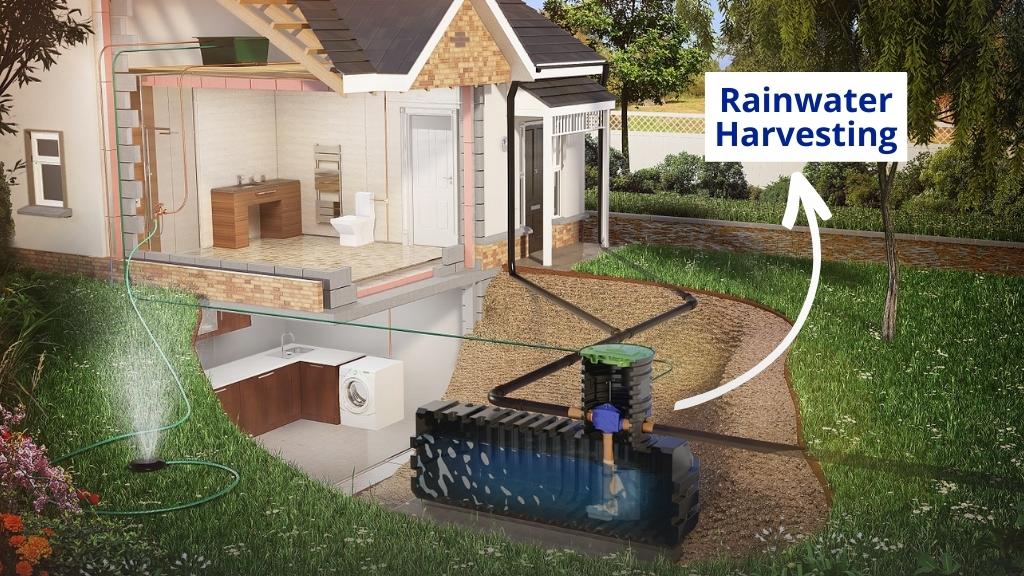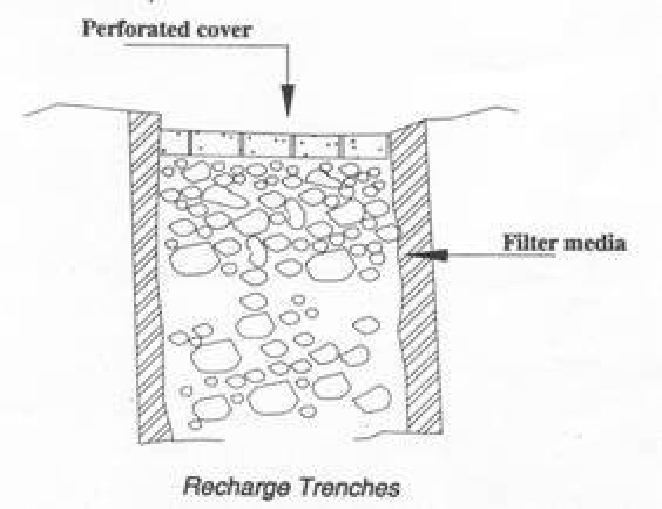
The rainwater harvesting is the practise of gathering and storing rainwater for on-site use as opposed to letting it flow off. Irrigation and gardening are just two uses for the water that is maintained in storage. Rooftop and surface runoff collection are the two main ways to collect rainwater.
This approach can significantly lessen the negative consequences of growing water scarcity in light of the dwindling groundwater levels and shifting climatic circumstances. Reserving rainwater may improve local aquifers, lessen urban floods, and most importantly, it can guarantee water supply in areas with limited water supplies.
This page covers a variety of rainwater harvesting methods.
Techniques Of Rainwater Harvesting System
Below we have noted down the different techniques used in rainwater harvesting systems.
1. Rooftop rainwater harvesting system
It is a method for obtaining rainwater directly from the source. The rooftop rainwater harvesting method includes converting the roof of a house or structure into a reservoir in order to collect rainfall.
It can be maintained in a tank or delivered to an artificial recharge system. If done properly, this method can assist raise the level of the groundwater nearby and is less costly.
2. Surface runoff rainwater harvesting system
Rainwater runs off as surface runoff in metropolitan areas. By using the proper techniques, this runoff may be captured and utilized to recharge aquifers.
Rooftop Rainwater Harvesting Methods Components
The following are the rooftop rainwater harvesting system’s primary component sub-components:
Catchment
The surface that successfully collects rainfall is referred to as the catchment in a rainwater collecting system. It might be a terrace, a courtyard, or an open space that is either paved or unpaved.
RCC/stone roofing materials can be used for the terrace’s flat or sloping roof. As a result, the area that delivers rainwater to the system for collecting it is known as the catchment.
Transportation
Rainwater that comes from the rooftop should be transported to the system for storage or harvesting using water pipes or drains. Water pipes (ISI HDPE/PVC pipes) are supposed to be UV-resistant and have the necessary capacity.
Water from sloping roofs may be collected by gutters and sent through a pipe. To keep floating trash in place, wire mesh is required at the terraces’ drain mouths.
First Flush
To prevent potential pollutants from the atmosphere and the catchment roof from contaminating the storable/rechargeable water, the initial rain shower must be stopped. The first flush, a device, is used to remove the water from the first shower.
It will additionally assist in clearing away the silt and other debris that dry seasons leave on the roof. At the end of each drainpipe, initial rain separators should be installed.
Filter
There is a lot of ambiguity around the rooftop rainwater harvesting system since worries have been raised that rainfall may contaminate the groundwater. And there is a little possibility that this concern might materialise if the proper filtering method is not employed.
Second, extreme caution must be exercised to ensure that subterranean sewer drains are not damaged and that there are no nearby leaks.
To efficiently remove turbidity, color, and microbes from water, filters are utilized. Water should flow through filters after the initial downpour.
On top of the storage tank, gravel, sand, and “net” mesh filter are developed and installed. To keep the rainwater in the storage tank clean, this filter is crucial. It prevents organic materials, such as leaves, silt, dust, and dust mites, from getting into the storage tank.
Daily cleaning of the filter medium is required following each rainstorm. Filters that are clogged may overflow because rainfall cannot easily enter the storage tank. Before being reinserted into the filter, the sand or gravel media has to be removed and cleaned.
Although there are many various kinds of filters in use, their primary purpose is to clean water. The section that follows provides descriptions of several filter types:
Gravel Sand Filter
These brick-built filters with pebble, sand and gravel fillets are often used filters. Each layer should be divided using the wire mesh.
Filter with charcoal
Charcoal filters can be produced on-site or in a drum. Sand, gravel, pebbles, and charcoal should all be placed within the drum or chamber. Each layer should be divided using the wire mesh. If there is any smell, the fine layer of charcoal absorbs it.
Filter for PVC pipes
For the construction of this filter, PVC pipe in lengths between 1 and 1.20 metres can be utilised; pipe diameter is determined by the size of the roof. 8 inches dia. pipe should be used rather than six inches dia. pipe for roofs greater than 1500 square feet. The pipe is divided into three pieces by wire mesh.
Sand and gravel should be used in alternate proportions to fill each component. Another option is to sandwich a layer of charcoal between two layers.
The filter should have the necessary size reduction at both ends to link the input and exit. In the system, this filter might be positioned either vertically or horizontally.
Sponge filter
It is a simple filter made from a PVC drum with a sponge layer in the middle. It is the most basic and affordable kind of filter that is suitable for houses.
Methodology of Rainwater Harvesting
Illustrations of varied rooftop rainwater collection techniques are provided in this section to aid.
Storage for immediate use
This method involves funnelling rainwater that has gathered on the building’s roof into a tank with storage capacity. The availability, water and rainfall use of the watershed must be taken into account while designing the storage tank.
Every single drainpipe should include a filtration system, a first flush mechanism, and a mesh filter at the mouth before linking to the storage tank. Every tank has to have a way to let extra water out.
More water might be added to the recharging system. For recreational activities like laundry and gardening, storage tank water can be used. This is among the most cost-effective ways to collect rainwater.
The main advantage of capturing and utilizing rainwater in the rainy season is not only to preserve water from usual sources however also to lower energy costs for transportation and water distribution .
Groundwater Aquifer Recharge
There are several structures that may be used to replenish groundwater aquifers such that precipitation seeps into the earth as opposed to draining away from the surface. The following are the most popular recharge techniques:
- Recharging of bore wells
- Soakaways or Recharge Shafts
- Recharge pits
- Percolation Tanks
- Recharge Trenches
- Recharging of dug wells
1. Recharging of bore wells

Rainwater that has gathered on the building’s roof is delivered there by drainpipes and is then collected in a settlement or filter tank. After settlement, bore wells are supplied with cleaned water to top off deep aquifers. Bore wells can also be filled up after being abandoned.
The catchment area, amount of rainfall, and recharge rate may all be used to determine the settlement tank/filtration tank’s proper capacity. The recharging structure has to be kept clear of floating debris and silt to avoid obstruction.
The first one or two showers should be diverted with a rain separator to avoid pollution.
2. Soakaways or recharge shafts

In alluvial or less permeable topsoil areas, soak-away or recharge shafts are offered. These are the 30 cm-diameter bored holes, which, depending on the thickness of the previous layer, may reach depths of 10 to 15 m. A PVC/MS pipe with slots or holes should line the bore to prevent the collapse of the vertical sidewalls.
The requisite size sump is constructed at the top of the soakaway to catch runoff before it filters through. The sump should include filter media.
3. Recharge pits

Small, regularly spaced holes with weep holes that are encircled by a brick or stone masonry wall are called recharge pits. The top of the pit may be covered with perforated covers. The bottom of the pit should be filled with filter material.
The capacity of the pit may be determined using the catchment area, rainfall totals, and soil recharge rates. Depending on the depth of the previous stratum, the pit’s dimensions typically range from 1 to 2 metres in width to 2 to 3 metres in depth.
Tiny dwellings and shallow aquifers can be refilled using these holes.
4. Percolation tanks

A portion of land with sufficient permeability is submerged in man-made surface water pools called percolation tanks, which allow for sufficient percolation to recharge the groundwater. Where there is availability to land and adequate topography, they can be built on enormous campuses.
Surface runoff and roof runoff can both be directed into this tank. Water that has accumulated in the tank percolates through the solid to raise the groundwater.
The water that has been saved can be used for gardening and other practical purposes. Percolation tanks need to be placed in all urban greenbelts, parks, and gardens.
5. Recharge trenches

Where the top impermeable layer of soil is shallow, a recharging trench is offered. Porous materials, such as pebbles, boulders, or brickbats, were used to line the recharge trench’s excavation. It is often designed to catch surface runoff.
Bore wells can be used as recharging shafts inside the trench to increase percolation. The length of the trench is determined by the expected amount of runoff.
Playgrounds, little parks, roadside drainage, and tiny homes might all benefit from using this technique. The recharging trench might be 1.5 metres deep and 0.50 to 1.0 metres broad.
6. Recharging of dug wells

Digged wells may serve as structures for recharging. Rainwater from the roof is routed to drill wells after passing through the filter bed. To accelerate recharging, dug wells must be regularly cleaned and desalted. Employing the filtration method suggested for bore well recharge is one alternative.
Benefits of Using Rainwater Harvesting Methods
Ecological advantage
It is eco-friendly to store water underground. The use of collected rainwater has enormous ecological advantages. Directing the runoff into big tanks for recycling, lessens the effects of flooding and lessens the strain on drainage systems. Groundwater is not immediately exposed to evaporation and pollution since no land is lost for storage and no population is affected. Additionally, it lessens the chance that rivers may dry up.
Decreases the need for groundwater
Another significant advantage is that it raises groundwater levels and decreases the requirement for potable water by increasing aquifer production. It is absolutely necessary, especially in places where the water table is low.
Lower Water Bills
Since rainwater collecting systems are not used for drinking, cooking, or other delicate purposes, they are far easier to operate, offer high-quality water, and reduce reliance on wells. In comparison to alternative purifying or pumping processes, the setup costs for harvesting techniques are significantly lower. Subsurface reservoir recharging is also less expensive than surface reservoirs.
Lowers floods and erosion near structures
By collecting rainfall and lowering the flow of stormwater to minimize urban floods, it lessens soil erosion and flood threats. Most structures with rainwater harvesting systems have an integrated catchment space on top of the roof that can hold huge amounts of water in the event of rainstorms.
An effective method for irrigation
Rainwater collecting makes it possible to gather enormous volumes of water and lessens the impact of drought. The majority of rooftops offer the essential platform for water collection. Because it largely lacks dangerous compounds, rainwater is good for irrigation.
Rain Water Harvesting Methods FAQs:
1. What makes up the rooftop rainwater harvesting system?
It consists of the catchment, first flush, transportation and filter.
2. What does rainwater collection entail?
The technique of collecting and storing rainwater for on-site reuse, as opposed to having it flow off, is known as rainwater harvesting. These preserved liquids are used for a variety of purposes, such as gardening and irrigation.
3. What techniques are used to collect rainwater?
Surface runoff harvesting and rooftop rainwater harvesting are the two methods for collecting rainwater.






